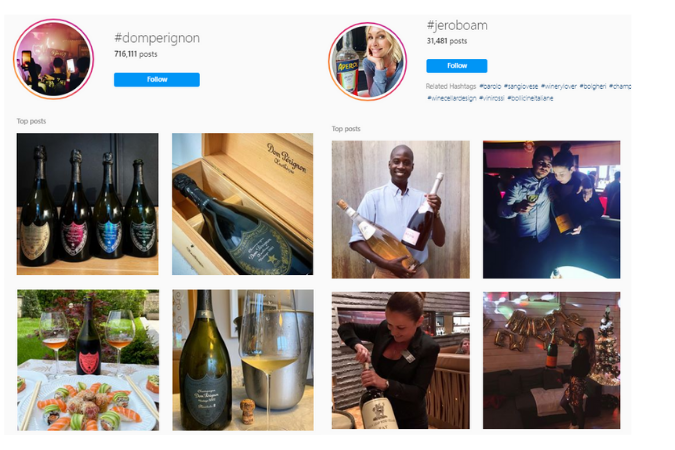Many things have changed in lockdown. But sharing your top bottles on social media isn’t one of them. If anything, the Instagram lens has only become sharper as people dig deeper into their cellars.
Interesting word that; sharing. “I shared it on social media”. If we’re honest, it’s a bit more “I showed it off on social media”. But sharing does sound nicer. Why do we do it? Certainly, there’s a peacock effect to all of this. We lack an iridescent feathery train, so we have to find other ways to display to fellow members of our species. Where bonobo chimps have a cacophony of shrill and piercing copulation calls, we have 750,000 Instagram posts tagged #domperignon. And you don’t need to skim through Freud’s lectures to know why there are more than two million tagged #magnum. (Frankly, the 31,000 people using #jeroboam are overcompensating.)

Wine is more versatile than a fancy tail, a ruddy bottom or a screeching call. Wine displays and it communicates. But taste, don’t forget, is a word that has two different meanings. We can declare that we adored the opulent fruit of 2010 Cheval Blanc, held in place by that ribbon of acidity so characteristic of the terroir, and we’d be describing its taste – the perception of flavour. But we’re also declaring that we have the taste, the discernment, to choose such a wine.
There’s a Nancy Mitford quality to this. It’s not the done thing simply to post pictures of the most expensive bottles. That’s like revealing you bought your own furniture. No, you have to have the right bottles. Post too young a vintage from Château Pavie and you might as well admit you drank it on a “settee”. But a lesser wine from Pierre-Yves Colin-Morey, say, is a richly textured hieroglyphic that declares “I say lavatory, not toilet”.
We can call it a certain form of snobbery, certainly. The word “snob” was popularised by William Makepeace Thackeray in his Book of Snobs in 1879, and a series of articles for Punch magazine. Interestingly when he gets to wine, he doesn’t have one sort of snob. He has three: Snobling, Fledgling and Gosling.
- “‘This bottle’s corked,’ says Snobling; Mr. Sly, the butler, taking it away, returns presently with the same wine in another jug, which the young amateur pronounces excellent.
- ‘Hang Champagne!’ says Fledgling, ‘it’s only fit for gals and children. Give me pale sherry at dinner, and my ‘23 claret afterwards.’
- ‘What’s port now?’ says Gosling. ‘Disgusting thick sweet stuff—where’s the old dry wine one USED to get?’”
Today’s Snobling posts a picture of a low-intervention Rikatsiteli in an east London wine bar; Fledgling shows us his En Rama Sherry; and Gosling favours a bottle of Domaine de la Côte as part of a love letter to Rajat Parr.
We can declare that we adored the opulent fruit of 2010 Cheval Blanc – but we’re also declaring that we have the taste to choose such a wine
The French sociologist Pierre Bourdieu wrote 617 pages on this in his “Distinction: a social critique of the judgement of taste”. (Say what you like about the French, they don’t half go on.) Bourdieu describes how there is economic capital, but also social capital and cultural capital. 31,000 people have posted pictures of a bottle from Domaine de la Romanée-Conti on Instagram. That’s six times the domaine’s annual production. But the ones who really did buy a bottle are all proof of Bourdieu’s thesis that – at least in part – taste is a function of access to economic capital. Cash.
On the other hand, you might picture yourself with a bottle of 1959 Latour, discovered when you cleared out your father-in-law’s cellar. Here, you are displaying social capital. Bourdieu saw in social capital the cold realities of social inequality. Not what you know, but who you know. A world where elite jobs go to posh men. I love the wine business dearly, but this does give a different feel to lots of pictures of wine-trade dinners.
And if you have a bottle of Cos Frappato? Or Viña Tondonia? Or Gravner Ribolla Gialla? (Frankly anything orange.) You might be showing less cash, but you’re displaying oodles of cultural capital. This is the embodiment of what you know. The wine equivalent of listening to Stockhausen, or reading “challenging” fiction.

What you have. Which is your tribe. What you know. I’m not saying you didn’t love that last bottle you shared on social media. But you were telling the world a lot more than the simple fact that you thought it was delicious. So next time someone posts a covetable bottle on Instagram, ask yourself: was it because it was good to drink? Or good to think?





